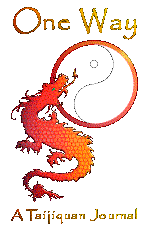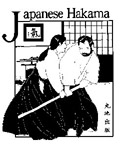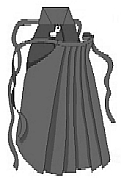
The Hakama & Keikogi

The hakama is the long skirt-like garment worn in Japan. There are two types, the skirt-like version and the pants-like version, a hakama with "legs" called a joba hakama. Today, in Japan hakamas are worn by men and women for everyday and formal occasions. The skirt-like hakama may be worn over a kimono; and either type of hakama may be worn over a hakama-shita, a shorter version of the kimono. Martial arts practitioners wear the joba-hakama. The top we wear for kobu-jutsu practice is the keikogi, or practice gi. But the hakama can also be worn over the familiar white practice gi, top and bottom. The embroidered shiro musashi top is also sometimes worn. Originally, the hakama was worn as an outer garment to protect samurai horsemen's legs from brush, weeds, etc., similar to cowboys' leather chaps. In Japan, since leather was so very scarce, heavy cloth was used in its place. After the samurai made the transition from mounted soldiers to foot soldiers, they continued to wear the hakama largely due to the fact that it set them apart and made them easily identifiable.
The hakama is said to symbolize the seven virtues or codes of Budo (Bushido). I have found two differing lists, "virtues" and "codes." The list of "virtues" reads: jin (benevolence), gi (honor and justice), rei (courtesy and etiquette), chi (wisdom and intelligence), shin (sincerity), chu (loyalty), and koh (piety). The list of "codes" reads: jin (benevolence), gi (justice), rei (politeness), yuu (bravery), makoto (veracity), meiyo (honor), and chuugi (loyalty). This list seems to be the one represented by the pleats. We find all these qualities in the distinguished samurai of the past. The hakama prompts one to reflect on the true nature of bushido. Wearing it symbolizes the traditions that have been passed down from generation to generation. In practice one should strive to polish the seven traditional virtues. The hakama has 7 pleats in it (5 in the front, 2 in the back) and there are many varying interpretations of the meanings. Commonly accepted meanings of the hakama pleats:
Note: The numbers do not necessarily correlate with the positions of the pleats.
Other interpretations: According to the Kendo America web site (www.kendo-usa.org), the meanings of the pleats of the hakama are as follows: 1. Jin— Mercy The meanings for 6 and 7 were unclearly assigned. There was a note: "Makoto = Chu-Kou Loyalty/Allegiance (respect for your parents)" Another Interpretation of the meaning of the hakama pleats is that the five pleats in the front are the five virtues; gotoku, of Japanese traditional society, with the one in the back representing all five virtues combined as one major virtue, that of being a complete human being. The five virtues are: Chu: loyalty Five is usually used as gotoku and not only means "five virtues," but it also means a stand for the iron kettle used to heat water in old Japanese houses, which could be interpreted to mean the five virtues are a foundation.
|
